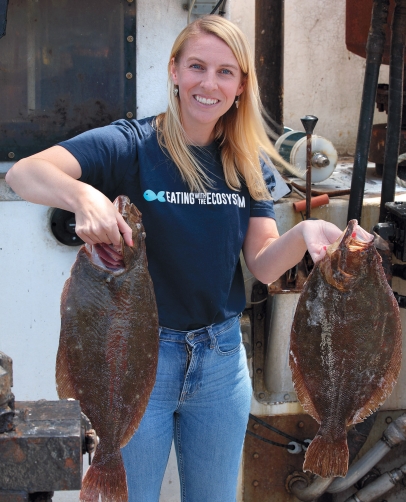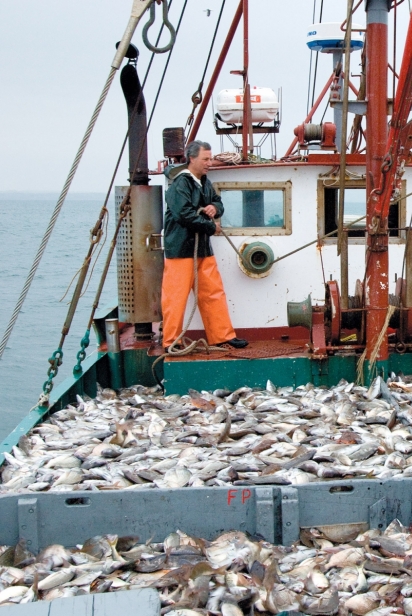Eat Like a Fish
Cast a Wider Net and Explore the Many Pleasures of Lesser-Known Fish Species
From July until about Halloween, we eat a lot of scup at home, pan-seared in butter. The kids like it crispy. We also eat blackfish and striped bass, fluke, bluefish and black sea bass. Last winter I became obsessed with butterfish and whiting, and found myself cooking them again and again, unadorned, until I figured out the best way to prepare them.
I like eating fish as a regular thing; nothing fancy, nothing planned. Just simple plates of food, kind of like eggs in the morning.
This, of course, still takes some work—not so much the cooking, but finding the fish. They don’t jump from the sea into my frying pan. And even living a few miles from Point Judith, close enough that I can almost smell the rich bouquet of bait barrels, fish, steel, diesel and gulls, these particular fish are not guaranteed. I need to hunt, source and ask around—which takes work.
A FISH ECONOMY
As Rhode Islanders, we live amongst a huge privilege of fish, a variety of tastes and textures, which rival any other coastal state in the country. In 2017, according to the National Oceanic and Atmospheric Administration (NOAA), Rhode Island landed 84 million pounds of seafood. That’s a staggering amount of food. So much it drives a whole fish economy—boats, trucks, processors and consumers. The list of species runs from quahogs to monkfish and everything between. But the big four for volume here in Rhode Island are two species of squid followed by butterfish and scup.
And, much of our fish leaves Rhode Island. It always has. For species like scup, whiting and butterfish, just about all of it does. Scup and whiting go to New York, Philadelphia and Baltimore and much of the butterfish heads to Japan and China. Squid—our poster species—is sold across the country.
Many of these market channels have been set in place since at least the 1970s. There is history there, momentum. In a sense, Rhode Island’s boats and fish merchants have focused their energy catching and selling fish that other ports like New Bedford, Boston and Gloucester didn’t much bother with.
While those ports focused on codfish, scallops, pollock, haddock and flatfish, Rhode Island developed markets for squid, scup, whiting and butterfish. High volume, cheap price.
For years the hub for all this, Point Judith, was known as a “swill” port. Most of us living in Rhode Island hadn’t a clue this commerce was even happening. If you were to follow a box of scup off a fishing boat from Point Judith to New York, you would get a sense of “the scup economy,” and the varied races and multi-ethnicities who eat and enjoy these fish.
So why is it tricky finding these smaller species in Rhode Island fish markets? The fish are abundant and available year ’round. Tons of them literally get landed and eaten—just not here. And even with more familiar Rhode Island species like black sea bass, fluke (also known as summer flounder) and striped bass, it can be a challenge.
“Most of our fish markets don’t reflect what is locally available,” said Kate Masury, director of Eating with the Ecosystem, a nonprofit that promotes a place-based approach to sustaining New England wild seafood. “For fish like scup, whiting and butterfish—they can be very hard to find.”
EAT LIKE A FISH
Eating with the Ecosystem recently published a report called “Eat Like a Fish,” which assessed the availability and diversity of seafood in the New England marketplace. The program centered around the work of 86 citizen scientists, people spread out across all the coastal New England states. For six months in 2017, from May to October, these individuals went to their local fish markets in search of fish. Each week, they tried to locate four varieties of randomly selected local seafood.
“What we found was that we can do a better job in our fish markets,” said Masury. “Forty-seven out of 52 total species were found less than 50% of the time. Thirty [of the 52 species] were found less than 10% of the time.”
For Rhode Island fish markets, here is some of the breakdown: Squid was found 62% of the time it was searched for; scup 10%; fluke 22%; striped bass 10%; butterfish 2%; scallops 75%; whiting 0%.
“One interesting thing that came out of the study was that our citizen scientists, who were not necessarily fish eaters in the beginning of the study, became fish eaters by the end. They were forced to try lots of different kinds of fish. They really got into it,” said Masury.
There are a few Rhode Island markets that do make a push to carry local fish. Fearless Fish Market in Providence has a display case that reflects what Rhode Island boats are currently landing. On any given day, Fearless has scup, fluke, striped bass, whole squid or black sea bass. Many of the fish are sold whole, which is also a welcome shift.
“I want people to try new things, to be fearless in their fish choices,” said store owner Stuart Meltzer. “Whole scup is a staple of mine. Customers are enjoying it, too. I’m committed to supplying locally landed Rhode Island fish. I think it’s important.”
Most Americans are not fish eaters. We eat more pork, chicken and beef. And when we do eat fish, we eat shrimp, salmon, codfish, halibut, ahi tuna and tilapia. These fish are generally sold filleted and the price is kept low by the supply from a much larger world market.
In contrast, our local fish, when you do see them in the case, tend to be more expensive, especially for species like striped bass, fluke and black sea bass—which tend to be lower in catch volume, higher in price. With butterfish, scup and whiting, it’s the opposite. The price tends to be lower, the volume higher—but the odd thing is, they are even harder to find.
Much of what we yearn for in seafood is tied to our cultural roots as well. For example, my wife, who was raised on home-cooked Portuguese cuisine in East Providence, grew up with a different idea about fish. When I started bringing whole whiting home and cooking them on the grill, her fingers tore those fish apart, expertly removing the bones in one sweep, like it was nothing. For other friends of ours, that process of deboning a small whole fish for dinner would be an Instagram moment—a novelty.
GROW AN APPETITE FOR SMALLER FISH
Yet it’s those smaller whole fish that are important to the future of our fisheries. Smaller fish tend to be fast growers and lower on the food chain. I’ll admit I still buy salmon from Norway and haddock from Iceland for the family, but I also try to blend in lots of local seafood.
“We need young fish eaters–kids who are brought up on fish,” said Masury. “We also need to immerse ourselves in buying and cooking fish. I want to see even small amounts of scup, butterfish and fluke in our local markets. As consumers, we need to ask for them; get a small demand going. And by spreading out our fish choices, we actually eat more sustainably. But fish markets only stock what they are going to sell. So we need to ask for it and create the demand.”
Things are slowly improving; each year Rhode Island squid is making itself better known, inching its way up the fish market food chain.
And the lesser knowns—scup, whiting, butterfish—those will take a campaign until we find them more readily available at the fish counter. They are tasty once you understand a few things about how to prepare them. In fact, a number of chefs around the state are exploring ways to serve these fish, and the number is growing. I recently had a whole whiting at Plum Point Bistro in Saunderstown served with herbs on a wooden platter that blew me away. It looked beautiful, all done up—and it tasted delicious.
Most of the millions of pounds of scup, whiting and butterfish are being eaten by people in urban centers far from here—in dishes often tied to their cultural heritage as something simple and good to eat, not necessarily haute cuisine. I want to eat and enjoy these smaller species, too, plus I’d like to see more on the menu when we’re dining out. In the meantime, my kids will fight over the crispy edges of the pan-seared scup. For me, that’s the true taste of satisfaction.
For more about Eating with the Ecosystem and their approach to sustaining new England’s wild seafood, including the “Eat Like a Fish” research study and upcoming events, visit EatingWithTheEcosystem.org. Join their “New England Seafoodies” group on Facebook, too.







